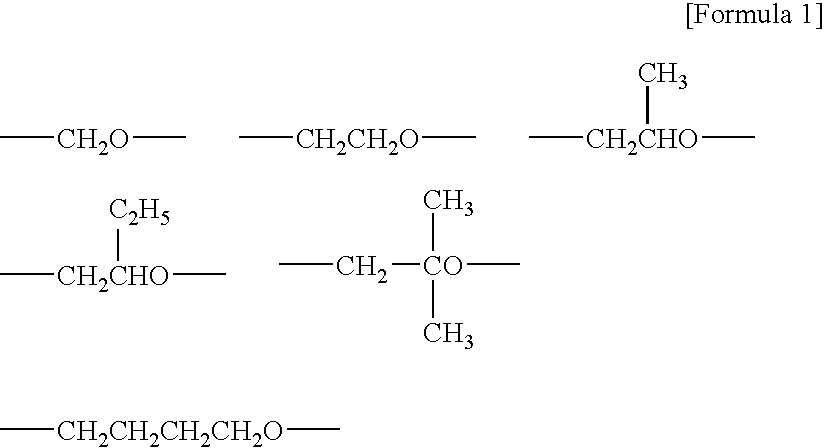Curable composition
- Summary
- Abstract
- Description
- Claims
- Application Information
AI Technical Summary
Benefits of technology
Problems solved by technology
Method used
Image
Examples
synthesis example 1
[0312]Propylene oxide was polymerized in the presence of a zinc hexacyanocobaltate glyme complex catalyst, using as an initiator a mixture of polyoxypropylenediol having a molecular weight of about 2,000 and polyoxypropylenetriol having a molecular weight of about 3,000, the ratio by weight therebetween being 1 / 1, to obtain polypropylene oxide having a number-average molecular weight of about 19,000 (the molecular weight, in terms of polystyrene, measured by use of an liquid-sending system, HLC-8120 GPC, manufactured by Tosoh Corporation, a column, TSK-GEL H type, manufactured by Tosoh Corporation, and a solvent, THF).
[0313]Subsequently, thereto was added a solution of NaOMe in methanol in an amount of a 1.2-fold equivalent of hydroxyl groups of this hydroxyl-group-terminated polypropylene oxide, and then methanol was distilled off. Furthermore, thereto was added allyl chloride to convert the hydroxyl groups at the terminals to allyl groups. The process gave an allyl-group-terminate...
examples 3 and 4
[0322]In accordance with each formulation shown in Table 4, under conditions of a temperature of 23° C. and a relative humidity of 50%, individual components were weighed out and taken into a metallic can, and a spatula was used to knead the components sufficiently for 1 minute. The time when the kneading was ended was defined as the curing starting time, and the metallic can was allowed to stand still under conditions of a temperature of 23° C. and a relative humidity of 50%. A part of the composition was kneaded with the spatula, and the period until the viscous liquid crystal turned to a rubbery elastomer, which was defined as the gelation period, was measured as the curing period. The results are shown in Table 4.
TABLE 4ExampleComposition (parts by weight)34Main agent ((A) + (E))Main agent 1[1 ] 297[1] 297Lewis acid derivativeBF3 diethyl ether complex[3] 2[3] 2(B)solution(1)Amine compound (C)DBU(2)[4] 21-Phenylguanidine[4] 10solution(3)Compound (D) havingVinyltrimethoxysilane[2]...
examples 5 to 9
[0324]In accordance with the formulation shown in Table 5, the following were mixed with each other: the polymer (A1) yielded in Synthesis Example 1 as a polymer (A) having one or more reactive silicon groups; filler shown in Table 5 as filler (E); and a plasticizer and a thixotropic agent as other components. The components were kneaded with a three-axis paint roll to prepare a main agent 2.
TABLE 5Composition (parts by weight)Main agent 2Polymer (A)Polymer (A1)100Filler (E)WHITON(1)120TIPAQUE R820(2)20PlasticizerActcol P23(3)55Thixotropic agentDISPARLON 6500(4)2(1)Surface-untreated ground calcium carbonate (manufactured by Shiraishi Calcium Kaisha, Ltd.)(2)Titanium oxide (manufactured by Ishihara Sangyo Kaisha, Ltd.)(3)PPG 3000 (manufactured by Takeda Pharmaceutical Company Limited)(4)Aliphatic acid amide wax (manufactured by Kusumoto Chemicals, Ltd.)
[0325]At room temperature, 100 parts by weight of vinyltrimethoxysilane as a compound (D) having a reactive silicon group and 10 part...
PUM
| Property | Measurement | Unit |
|---|---|---|
| Temperature | aaaaa | aaaaa |
| Molality | aaaaa | aaaaa |
| Composition | aaaaa | aaaaa |
Abstract
Description
Claims
Application Information
 Login to View More
Login to View More - R&D
- Intellectual Property
- Life Sciences
- Materials
- Tech Scout
- Unparalleled Data Quality
- Higher Quality Content
- 60% Fewer Hallucinations
Browse by: Latest US Patents, China's latest patents, Technical Efficacy Thesaurus, Application Domain, Technology Topic, Popular Technical Reports.
© 2025 PatSnap. All rights reserved.Legal|Privacy policy|Modern Slavery Act Transparency Statement|Sitemap|About US| Contact US: help@patsnap.com

